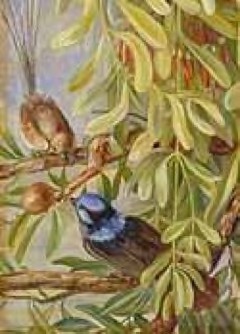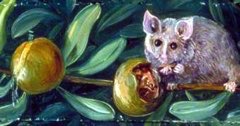 |
|
http://www.edibleplants.org |
 |
| http://www.edibleplants.org |
Translate this page:
Summary
Santalum spicatum commonly known as West Australian Sandalwood grows about 8m in height in the Western part of Australia. It has a crooked bole with rough, grey bark and stiff spreading branches. The flowers are small, green and red, carrion-scented, and in panicles. The fruits are green but turn brown. The essential oil from the wood is used medicinally against urinary tract infection. The fruits and pods are edible. The tree is harvested, mainly from the wild, for its valuable wood, which is the source of an essential oil. Propagation can be through seeds but mechanical scarification is required to increase the rate of seed germination.
Physical Characteristics

 Santalum spicatum is an evergreen Shrub growing to 4 m (13ft) by 4 m (13ft) at a slow rate.
Santalum spicatum is an evergreen Shrub growing to 4 m (13ft) by 4 m (13ft) at a slow rate.
See above for USDA hardiness. It is hardy to UK zone 10. The flowers are pollinated by Insects.
Suitable for: light (sandy), medium (loamy) and heavy (clay) soils, prefers well-drained soil and can grow in nutritionally poor soil. Suitable pH: mildly acid, neutral and basic (mildly alkaline) soils and can grow in very acid and saline soils.
It can grow in semi-shade (light woodland) or no shade. It prefers dry soil and can tolerate drought. The plant can tolerate maritime exposure.
UK Hardiness Map
US Hardiness Map
Synonyms
Eucarya spicata (R.Br.) Sprague & Summerh Fusanus spicatus R.Br.
Plant Habitats
Edible Uses
Edible Parts: Fruit Oil Seedpod
Edible Uses: Oil
The fruits and pods are gathered from the wild and eaten as food[303 ]. Seed kernels of sandalwood may be eaten and have formed a valuable part of the traditional Aboriginal Australian diet[303 ]. The kernels contain 45 - 55% oil, which is characterized by a high percentage of unusual acetylenic fatty acids[303 ].
References More on Edible Uses
Medicinal Uses
Plants For A Future can not take any responsibility for any adverse effects from the use of plants. Always seek advice from a professional before using a plant medicinally.
Urinary
The essential oil obtained from the wood is used medicinally, particularly as a disinfectant for the urinary tract[310 ]. The oil contains several medically active substances including fusanols, santalol and sesquiterpene alcohols[46 ].
References More on Medicinal Uses
The Bookshop: Edible Plant Books
Our Latest books on Perennial Plants For Food Forests and Permaculture Gardens in paperback or digital formats.

Edible Tropical Plants
Food Forest Plants for Hotter Conditions: 250+ Plants For Tropical Food Forests & Permaculture Gardens.
More

Edible Temperate Plants
Plants for Your Food Forest: 500 Plants for Temperate Food Forests & Permaculture Gardens.
More

More Books
PFAF have eight books available in paperback and digital formats. Browse the shop for more information.
Shop Now
Other Uses
Cosmetic Essential Fuel Incense Oil Soap making Soil conditioner
Agroforestry Uses: The ground under the canopy of this tree is usually littered with seeds and leaves these on decay replenish soil nutrients[303 ]. Because of its deep rooting habit, this tree could offer shade or support services yet compete minimally with other crop. However caution should be taken on account of its parasitic attributes[303 ]. Other Uses: The seed contains 45 - 55% oil, comprising about 49% oleic acid and about 40% ximenynic acid[303 ]. An essential oil, known as West Australian sandalwood oil, can be obtained by water or steam distillation of the wood[310 ].. This is a pale yellow viscous liquid with a soft woody, somewhat balsamic sweetness; its top note is rather dry-bitter and slightly resinous; its main constituent is santalol[310 ]. The oil is valuable in perfumery just like East Indian sandalwood oil[310 ]. The wood is used in China as a temple incense[46 ]. The heartwood is dark brown, and is surrounded by a pale coloured sapwood[303 ]. It used to be extensively cut and exported as sandalwood. It can be used for wood carving, incense making and for the extraction of the essential oil[310 ]. At present it is only harvested in small quantities[310 ]. The wood is an excellent fuel and has been used for firing brick kilns[303 ].
Special Uses
Scented Plants
References More on Other Uses
Cultivation details
A plant of drier, lowland areas in the tropics and subtropics, where it is found at elevations from sea level to 500 metres[303 ]. It grows best in areas where annual daytime temperatures are within the range 32° - 38°c, but can tolerate 7 - 45°c[418 ]. When dormant, the plant can survive temperatures down to about -4°c, but young growth can be severely damaged at 0°c[418 ]. It prefers a mean annual rainfall in the range of 200 - 400mm, but tolerates 150 - 500mm[418 ]. Prefers a sunny position, but can tolerate some shade[303 ]. Succeeds on a variety of soils from calcareous red earth to red earthy sands in Western Australia to solonized brown soils and shallow calcareous loamy soils in South Australia[303 ]. Tolerates soil salinity[303 ]. Prefers a pH in the range 5.5 - 6.5, tolerating 5 - 7[418 ]. Requires a well-drained soil[303 ]. Established plants are drought tolerant[418 ]. The plant is partially parasitic and relies on host plants for only water and soil nutrients, not for sugars, which is why it has green leaves and photosynthesizes[343 ]. Sandalwood trees are a root parasite of many species[303 ]. Some commonly recognized hosts are Eucalyptus salubris, Eucalyptus loxophleba, Casuarina cristata subsp. Pauper, Acacia aneura, Atriplex vesicaria, Pittosporum phillyreoides, Acacia acuminata, Senna siamea and Pongamia pinnata[303 ]. It normally has more than one host at a time[343 ]. Flowering is sporadic because of the irregular rainfall in most areas where the plant grows. Flowers are carrion-scented and nectariferous, attracting a wide range of insect pollinators[303 ]. Plants do not usually survive fires in the wild[303 ]. The estimated maturation time for the sandalwood in Kalgoorlie District, Australia is 50 - 100 years[303 ]. Sandalwood is harvested by uprooting trees from the ground[303 ]. The roots, stems and large branches are all utilized down to 2.5 cm diameter, dead sandalwood stems are also used[303 ].
References Carbon Farming Information and Carbon Sequestration Information
Temperature Converter
Type a value in the Celsius field to convert the value to Fahrenheit:
Fahrenheit:
The PFAF Bookshop
Plants For A Future have a number of books available in paperback and digital form. Book titles include Edible Plants, Edible Perennials, Edible Trees,Edible Shrubs, Woodland Gardening, and Temperate Food Forest Plants. Our new book is Food Forest Plants For Hotter Conditions (Tropical and Sub-Tropical).
Shop Now
Plant Propagation
Seed - mechanical scarification improves germination rates[303 ]. In the wild, the seed germinates after extremes in temperature and rainfall[303 ]. Field studies indicate that only 1 - 5% of the seeds germinate[303 ]. The rate of germination is higher in reserves and protected research and plantation areas, but is still less than 20%[303 ]. The establishment of the plant on an operational and plantation scale can be achieved by sowing 4 seeds per spot in well-drained sites, 50 - 70 mm below the soil and mulching in a small depression at the drip line of the south side of a suitable host plant[303 ]. The seedlings tend to die if their roots fail to attach to suitable hosts. The deaths therefore may be due to the inability to obtain some type of element for which the host is essential or the inability to take up sufficient nutrients to maintain growth[303 ]. Cuttings.
Other Names
If available other names are mentioned here
australian sandalwood, bois de santal d'australie, oil of australian sandalwood, western australian sandalwood.
Native Range
AUSTRALASIA: Australia (South Australia (Flinder‘s Range), Western Australia)
Weed Potential
Right plant wrong place. We are currently updating this section.
Please note that a plant may be invasive in one area but may not in your area so it's worth checking.
Conservation Status
IUCN Red List of Threatened Plants Status : This taxon has not yet been assessed

Growth: S = slow M = medium F = fast. Soil: L = light (sandy) M = medium H = heavy (clay). pH: A = acid N = neutral B = basic (alkaline). Shade: F = full shade S = semi-shade N = no shade. Moisture: D = dry M = Moist We = wet Wa = water.
Now available:
Food Forest Plants for Mediterranean Conditions
350+ Perennial Plants For Mediterranean and Drier Food Forests and Permaculture Gardens.
[Paperback and eBook]
This is the third in Plants For A Future's series of plant guides for food forests tailored to
specific climate zones. Following volumes on temperate and tropical ecosystems, this book focuses
on species suited to Mediterranean conditions—regions with hot, dry summers and cool, wet winters,
often facing the added challenge of climate change.
Read More
Expert comment
Author
(R.Br.) A.DC.
Botanical References
Links / References
For a list of references used on this page please go here
A special thanks to Ken Fern for some of the information used on this page.
Readers comment
| Add a comment |
|
If you have important information about this plant that may help other users please add a comment or link below. Only comments or links that are felt to be directly relevant to a plant will be included. If you think a comment/link or information contained on this page is inaccurate or misleading we would welcome your feedback at [email protected]. If you have questions about a plant please use the Forum on this website as we do not have the resources to answer questions ourselves.
* Please note: the comments by website users are not necessarily those held by PFAF and may give misleading or inaccurate information.
To leave a comment please Register or login here All comments need to be approved so will not appear immediately.
|
Subject : Santalum spicatum
|
|
|
|